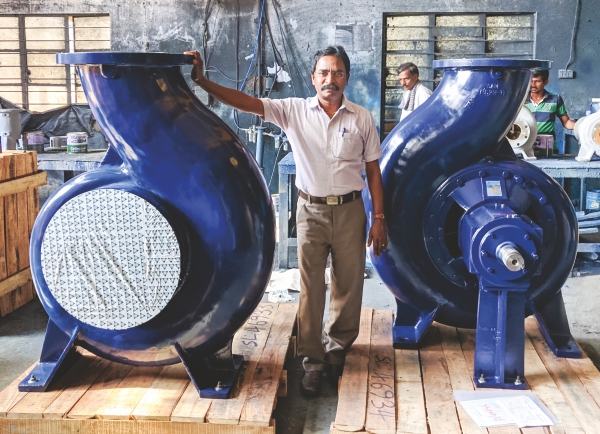
NPSH, Net Positive Suction Head, is the most talked about and critical term in the pump industry. Understanding it in the most practical way will help in avoiding a lots of pumping problems at site. In this article of Paper Mart, Mr. M. Maria Francis, Senior Vice President – Marketing, Sam Turbo Industry Private Limited, Coimbatore, lucidly explains the term NPSH, problems connected with it and guidelines to overcome them. Mr. Francis is a mechanical engineer from Madurai Kamaraj University, having an experience of 35 years in the pump industry.
NPSH is the most misunderstood term amongst the users of pumps. A proper understanding of this term will prevent many of the pumping problems usually encountered. While designing the pumping system or selecting and installing the pump, NPSH plays an important role. Before proceeding with NPSH, it is imperative to understand the terms vapour pressure and cavitations.
Vapour Pressure: Vapour pressure of a liquid is the pressure at which the liquid turns into vapour (vaporises). Each liquid has a specific vapour pressure.
Cavitation: In a pipe line or in a pump or in a system, if the prevailing pressure drops below the vapour pressure of the liquid, then the liquid turns into vapour and form bubbles. When these bubbles are carried to a high-pressure zone, they burst out/collapse. While doing so, they damage the surface with which they come in contact and also produce a noise. This phenomenon is called cavitation and is something which no one wants it to occur. Cavitation is heart failure of the pump.
Watch: JMC Paper Tech Launches New Subsidiary JMC Papers
NPSH Available & NPSH Required – Case Study
NPSH means “Net Positive Suction Head”. There are two terms namely – ‘NPSH available’ and ‘NPSH required’. The former is connected to the pumping system and the later to the pump.
Many authors/specialists in the pumps field explain NPSH in various ways. Let’s understand it in a practical and simple way. Let’s assume that a person living in Coimbatore is travelling to Chennai for a day’s trip. He has the ticket from Coimbatore to Chennai and INR 10,000 with him to meet his expenses in Chennai and for his return journey ticket which may cost him INR 2,000. When this person gets down in Chennai, the first thing he should take care of is his return journey ticket. This means that he should set aside INR 2,000 for the ticket and spend only the remaining amount of INR 8,000 towards his lodging, boarding, local conveyance etc. But he should not touch the INR 2,000 meant for the return journey. In case he spends beyond INR 8,000 in Chennai, then he would be stranded in Chennai, a situation he wouldn’t like to be in. On the contrary, if he spends less than INR 8,000 in Chennai, he would have more money than the cost of the ticket which will make his return journey pleasant.
In this example, the money required for the return journey ticket can be compared to the ‘NPSH required’ by the pump. The money available with the person after meeting all his expenses in Chennai can be compared with ‘NPSH available’ in the system. The money available at the time of commencement of the journey can be referred to the source pressure.
NPSH-R by the pump is the energy required to carry the liquid from the suction flange to the eye of the impeller. The impeller will add energy to the liquid only when the liquid reaches the eye of the impeller. Hence, some external source of energy should force the liquid up to the eye of the impeller. NPSH-R is also the frictional resistance experienced by the liquid from the suction flange to the eye of the impeller. To overcome this resistance offered, the amount of energy required is the NPSH required of the pump. NPSH required can also be defined as the pressure drop/ friction loss that occurs from the suction flange to the eye of the impeller.
Paper Mart: Does NPSH required by the pump vary with the flow rate of the pump?
M.Francis: Yes, the NPSH required of the pump increases when the flow rate delivered by the pump increases. This is mainly because the frictional loss due to the resistance offered by the pump from the suction flange to the eye of the impeller to the liquid increases as the flow rate increases.
PM: Why for the same flow rate/operating conditions, the NPSH of the pumps offered by the different manufacturers vary?
MF: The design of the pump offered by the various manufacturers are different and hence the NPSH required values are also different from each other.
PM: For a given application, what value pump should we select?
MF: Low NPSH of a pump gives more flexibility in designing the pumping system. The construction costs will be maximum. Referring to the example discussed earlier, if the cost of the return journey ticket is less, the person will have more money for his expenses in Chennai. Lowest NPSH also generally means that the pump will have the highest suction capability and it can pump liquid from the deepest point.
Also Read: Paper Mart Emagazine Apr-May, 2023
PM: Does the NPSH required vary with the diameter of the impeller of a pump?
MF: Yes, for a given pump, the NPSH required increases when the impeller diameter decreases. This is mainly because of the increase in the leakage losses and the internal recirculation of the liquid, when the impeller with the reduced diameter is used.
PM: How can we compute the NPSH available?
MF: NPSH available is the net energy available in the system to take care of the NPSH required by the pump. NPSH available = source pressure -/+ suction lift/head – suction losses – vapour pressure of the liquid at the operating temperature. We subtract the vapour pressure while computing NPSH available, because the net energy/head available should be more than the vapour pressure of the liquid at the operating temperature. Failing which the liquid will turn into vapour leading to cavitation. Referring to the example discussed, the money available with the person at the commencement of his trip is the source pressure. His expenses at Chennai are the suction losses and the balance/net money available is the NPSH available.

PM: Why should NPSH available be more than NPSH required by the pump?
MF: It has to be that way, as only then, the system can adequately meet the NPSH required by the pump. Referring to the example, the net/balance money available with the person should be more than the cost of the return journey ticket. Failing which, he would be stranded in Chennai.
PM: Having known the NPSH required of the pump selected, what should be done while designing/ installing the pumping system?
MF: Design the system with adequate source pressure. Provide positive suction head wherever possible and economical to do so. Design the suction piping carefully so that the losses in the suction piping are minimum. Install pipes and fittings with low friction factor.
PM: How can the NPSH required by the pump be verified by the manufacturer?
MF: By carrying out the NPSH test, verification can be done. NPSH tests are conducted in two different ways – by throttling method and by vacuum suppression method. In the throttling method, the losses in the suction side are varied by keeping the source pressure and the vapour pressure constant. This is also known as the open loop system. In vacuum suppression method, the source pressure is varied by keeping the suction losses and the vapour pressure constant. It is otherwise known as a closed loop system of testing the NPSH.
PM: How can the NPSH available in the system be improved to resolve cavitating in a new pump?
MF: This is a typical problem encountered many times. Depending on the site conditions, the solution will have to be worked out. However, a few general guidelines are given below to overcome this problem. a) The source pressure can be increased by lowering the pump(or) raising the tank from where the liquid is pumped out. b) The losses in the suction side can be reduced by eliminating unnecessary bends, valves etc. If necessary, rerouting of the piping can be done. c)If this does not improve the NPSH available, the next bigger diameter of the pipe can be opted and used.
When all these attempts fail to improve NPSH available, there are only 3 solutions which are
a) Changing the pump supplied
b) Use the existing pump at a flow rate lower than the specified rate of flow
c) Use the same pump with an inducer.
NPSH required by the pump varies with flow rate because the frictional loss due to the resistance offered by the pump from the suction flange to the eye of the impeller to the liquid Increases as the flow rate increases. The net energy/head available should be more than the vapour pressure of the liquid at the operating temperature. Failing which the liquid will turn into vapour leading to cavitation.



